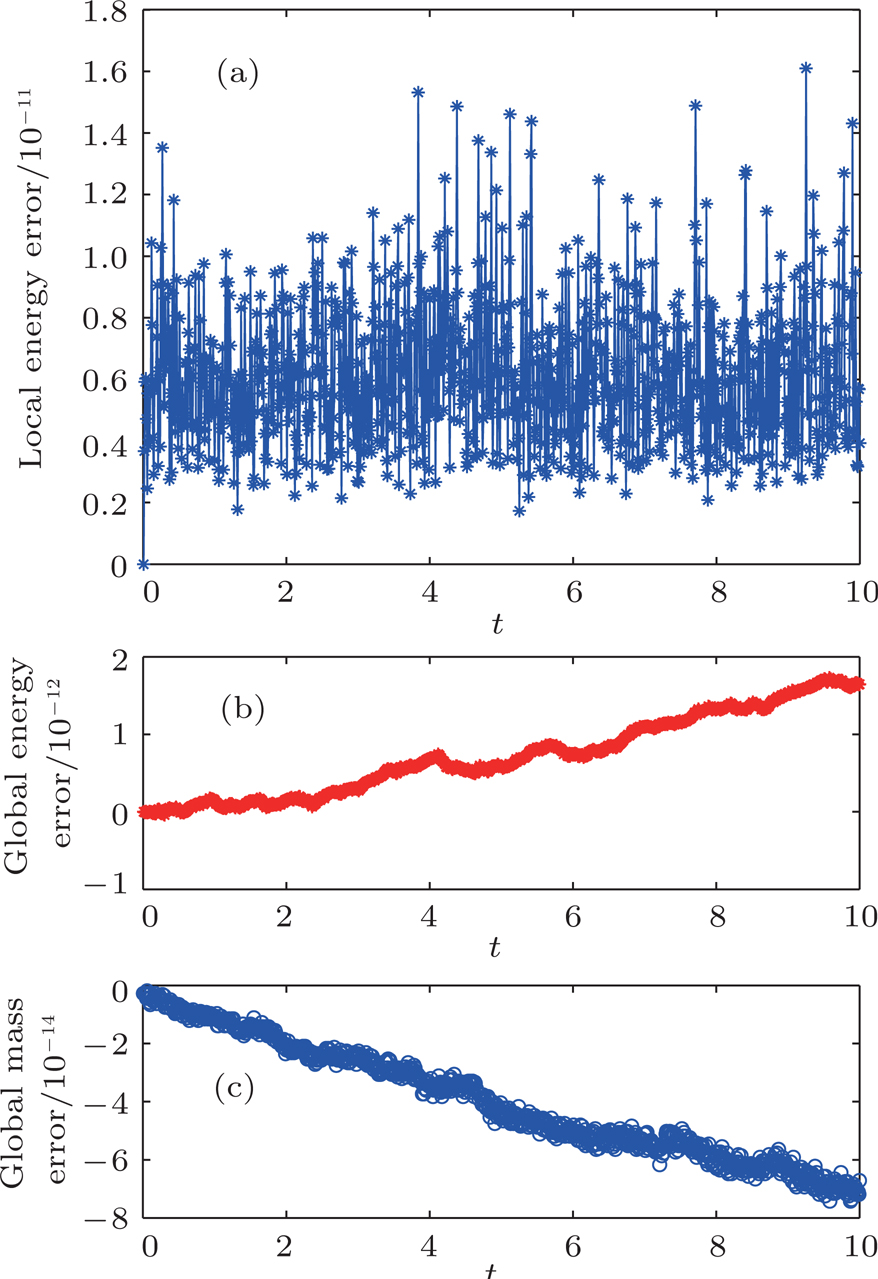† Corresponding author. E-mail:
In this paper, we propose a local conservation law for the Zakharov system. The property is held in any local time-space region which is independent of the boundary condition and more essential than the global energy conservation law. Based on the rule that the numerical methods should preserve the intrinsic properties as much as possible, we propose a local energy-preserving (LEP) scheme for the system. The merit of the proposed scheme is that the local energy conservation law can be conserved exactly in any time-space region. With homogeneous Dirchlet boundary conditions, the proposed LEP scheme also possesses the discrete global mass and energy conservation laws. The theoretical properties are verified by numerical results.
In this paper, we consider the following one-dimensional Zakharov system (ZS)[1]


Extensive mathematical and numerical studies have been developed for the Zakharov system during recent decades. Mathematically, the existence and uniqueness, the wellposedness and the regularity of smooth solutions, and the collision of solitons were established by Hadouaj, Bourgain, Colliander, and Fang.[2–6] Numerically, such as the spectral method,[7–11] the symplectic and multi-symplectic method,[12,13] the finite element method,[14] and the finite difference method[15–19] have been carried out for the Zakharov system. Nowadays, structure-preserving methods have been more and more popular and successfully applied to various PDEs.[20–23] To the best of our knowledge, there have been few approaches which can preserve the local energy of the Zakharov system in the literature. This motivates our study to introduce energy-preserving methods for solving the Zakharov system.
As we all know, the GECL (


Let N be a positive even integer. The domain 







In system (

In this section, some numerical experiments are carried out to show the performance of the proposed LEP scheme. Our computations will work on the spatial domain 






The invariants-preserving results are shown in Fig.
 | Fig. 1. (color online) (a) The variation of the local energy from t = 0 to t = 10; (b) the variation of the errors in the global energy, and (c) the global mass from t = 0 to t = 10, respectively. |
| Table 1.
Convergence order of the proposed LEP scheme (T = 4, τ = h). . |
| Table 2.
Stability test of the proposed LEP scheme. . |
 | Fig. 2. (color online) The values of 

|
In the present paper, we proposed a local energy-preserving (LEP) scheme to simulate the Zakharov system. The scheme preserves the discrete LECL in any time–space region, which is independent of the boundary conditions and is more essential than the discrete GECL. If the boundary conditions are suitable, summing the discrete LECLs over all space index leads to the GECLs. The scheme proposed in this paper extends the applying scope of the traditional global energy-preserving algorithm. Numerical results show the excellent performance in conserving local energy, global energy, and mass invariants. What is more, we find that the LEP scheme is stability and a second order convergence can be explicitly observed.
For the local energy conservation law of the Zakharov system (
| [1] | |
| [2] | |
| [3] | |
| [4] | |
| [5] | |
| [6] | |
| [7] | |
| [8] | |
| [9] | |
| [10] | |
| [11] | |
| [12] | |
| [13] | |
| [14] | |
| [15] | |
| [16] | |
| [17] | |
| [18] | |
| [19] | |
| [20] | |
| [21] | |
| [22] | |
| [23] | |
| [24] | |
| [25] | |
| [26] | |
| [27] | |
| [28] |




































